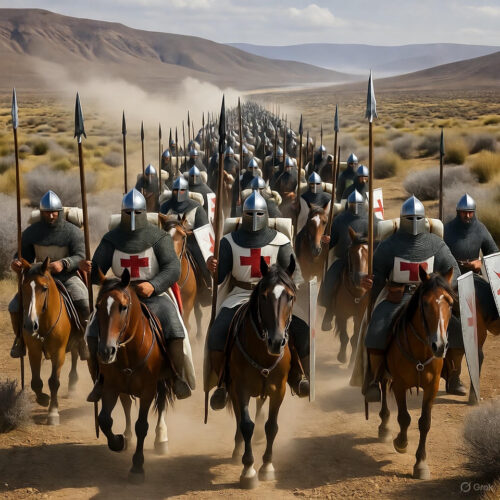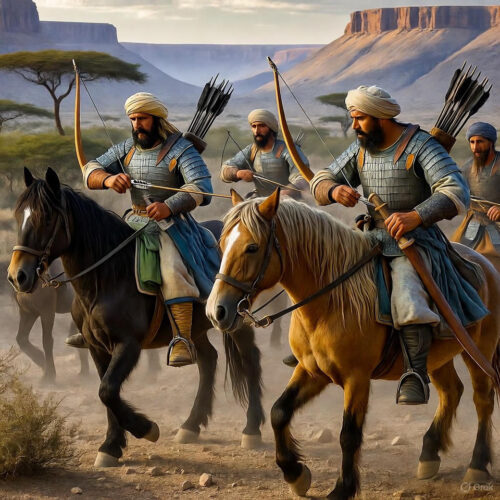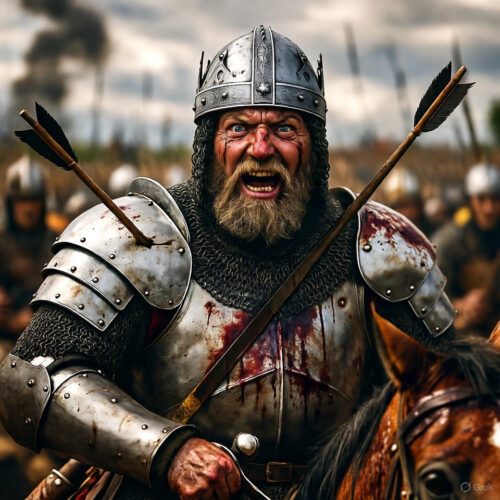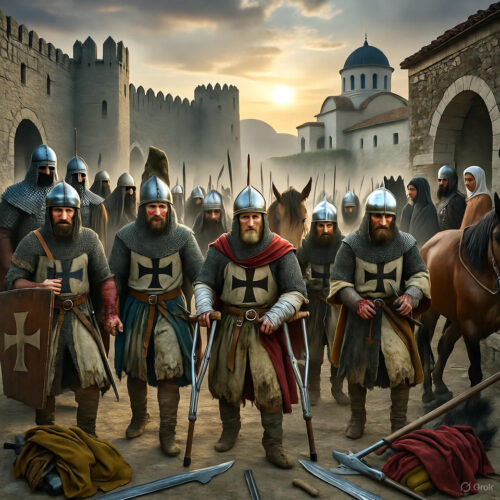Imagine a vast, sun-scorched plateau in the heart of Anatolia, where the dreams of holy warriors clashed with the harsh realities of warfare. On October 25, 1147, during the tumultuous era of the Crusades, a pivotal yet often overshadowed event unfolded: the Second Battle of Dorylaeum. This wasn’t just a skirmish; it was a catastrophic defeat for the German crusaders led by King Conrad III, marking a turning point in the ill-fated Second Crusade. While history books often glorify victories like the Battle of Agincourt on the same date centuries later, this earlier clash reveals the gritty underbelly of medieval expeditions—logistical nightmares, cultural clashes, and the unforgiving tactics of nomadic warriors. Dive with me into this riveting tale of ambition, ambush, and aftermath, where we’ll uncover layers of historical intrigue before drawing out timeless lessons that can supercharge your modern life.
To truly grasp the significance of this battle, we must rewind to the broader canvas of the Crusades. The First Crusade, launched in 1096, had been a surprising success for the Christian forces from Western Europe. They captured Jerusalem in 1099, establishing fragile footholds in the Levant known as the Crusader States: the Kingdom of Jerusalem, the County of Edessa, the Principality of Antioch, and the County of Tripoli. These outposts were precarious, surrounded by Muslim powers eager to reclaim lost territories. By the 1140s, the tide began to turn. In 1144, Zengi, the atabeg of Mosul and Aleppo, seized Edessa, the northernmost Crusader state. This loss sent shockwaves through Christendom, as Edessa was the first major Crusader holding to fall back into Muslim hands.
The fall of Edessa prompted Pope Eugene III to issue the papal bull Quantum praedecessores in December 1145, calling for a new crusade. This Second Crusade was unique in its scale and leadership. Unlike the First, which was led by nobles and knights, this one attracted royalty: King Louis VII of France and King Conrad III of Germany (also Holy Roman Emperor). Conrad, a seasoned ruler in his fifties, was motivated by a mix of piety, political prestige, and perhaps a desire to outshine his French counterpart. He assembled a massive army, estimates varying from 20,000 to as high as 50,000 men, including knights, infantry, and non-combatants like pilgrims and camp followers. The German force was bolstered by contingents from various principalities, reflecting the fragmented nature of the Holy Roman Empire.
Preparation for the crusade was no small feat. Conrad’s army gathered in Regensburg in May 1147, embarking on a grueling overland march through Hungary and into Byzantine territory. The Byzantines, under Emperor Manuel I Komnenos, were nominal allies but viewed the crusaders with suspicion. The First Crusade had strained relations, with crusaders accused of looting and failing to return conquered lands to Byzantine control as promised. Manuel, a shrewd diplomat, had recently signed a treaty with the Seljuk Sultanate of Rum, led by Mesud I, to secure his eastern borders. This pact would later fuel accusations of betrayal against the Byzantines.
As Conrad’s forces approached Constantinople in September 1147, tensions boiled over. The Germans camped outside the city walls, but clashes erupted—possibly sparked by overzealous soldiers or opportunistic locals. One incident involved a riot where crusaders set fire to a monastery, killing several inhabitants. Manuel, fearing a full-scale assault on his capital, hastily ferried the Germans across the Bosphorus to the Asian side. Here, the crusaders entered a liminal zone: the Anatolian frontier, a patchwork of Byzantine garrisons and Seljuk territories. The landscape was unforgiving—barren plateaus, scarce water sources, and rugged terrain that favored mobile cavalry over heavy infantry.
The Seljuks, descendants of Turkic nomads who had swept into the region in the 11th century, were masters of this environment. Under Mesud I, the Sultanate of Rum (named after “Rome,” as they claimed the legacy of the Byzantine lands they conquered) had consolidated power in central Anatolia. Their military strength lay in lightly armored horse archers, capable of swift hit-and-run attacks. These warriors, often ghazis (holy fighters) motivated by jihad, harassed supply lines and picked off stragglers with deadly precision. Conrad, aware of the dangers from the First Crusade’s experiences, planned to follow a route through Dorylaeum (modern-day Eskişehir, Turkey), site of a Christian victory in 1097 during the First Battle of Dorylaeum.
However, hubris and poor intelligence plagued the German campaign from the start. Conrad divided his forces, sending non-combatants and some troops via a safer coastal path, while he led the main army inland. Supplies were inadequate; the Byzantines provided markets, but prices were inflated, and foraging in the arid lands yielded little. As the army pushed beyond Nicaea, they entered the debatable lands—areas nominally Byzantine but effectively controlled by Seljuk raiders. For days, Turkish scouts shadowed the column, launching probing attacks. The infantry, poorly equipped and exhausted, bore the brunt. Chroniclers like Odo of Deuil, who accompanied the French crusade, later described similar ordeals, noting how the Turks “shot arrows from afar, wounding many.”
By mid-October, the situation deteriorated. The army had marched for about three days past Dorylaeum when the nobility urged Conrad to retreat and regroup. Water was scarce, morale low, and casualties mounting from constant skirmishes. On October 25, 1147, as the crusaders began their withdrawal, the Seljuks struck with full force. What followed wasn’t a pitched battle in the traditional sense but a rolling ambush that exploited the crusaders’ vulnerabilities.
The attack began at dawn. Seljuk horse archers, numbering perhaps 10,000 to 15,000, swarmed the retreating column. They used feigned retreats to draw out crusader knights, then wheeled around to unleash volleys of arrows. The German heavy cavalry, clad in chainmail and wielding lances, struggled in the open terrain. Infantry formations broke under the barrage, leading to chaos. Conrad himself charged into the fray, but his forces were outmaneuvered. Arrows rained down, piercing armor and felling horses. The king was struck by two arrows—one in the arm, another possibly in the head or shoulder—wounding him severely but not fatally.
Eyewitness accounts, though sparse, paint a vivid picture. The Annales Herbipolenses, a German chronicle, describes the Turks “surrounding them like a whirlwind.” William of Tyre, a later historian, blamed Byzantine guides for leading the army into a trap, though modern scholars like Jonathan Phillips dismiss this as scapegoating. The Syriac Chronicle marveled at the spoils: “The Turks grew rich, for they had taken gold and silver like pebbles with no end.” Baggage trains were abandoned, treasures looted, and prisoners taken—many of whom were later ransomed through Armenian intermediaries in Cilicia.
Casualties were staggering. While exaggerated claims suggest 90% losses, a more nuanced analysis by Phillips examines named participants: of 113 documented knights and nobles, 22 died, 42 survived, and 49 were unaccounted for, implying a casualty rate around 63%. The infantry suffered worst, decimated by arrows and pursuits. The professional knightly core, better armored, escaped total annihilation, but the army’s cohesion shattered. By evening, the survivors limped back toward Byzantine lands, the attacks ceasing as they reached safer territory.
The immediate aftermath saw Conrad and his remnants rendezvous with Louis VII’s French army at Nicaea. The combined forces opted for a coastal route, but even this was fraught with danger—more Seljuk raids, disease, and logistical woes. Conrad, recuperating from his wounds, sailed from Ephesus to Constantinople, where he reconciled with Manuel I. The emperor provided ships for the Germans to reach Palestine. The remaining crusaders pressed on to Attalia (modern Antalya), where many perished attempting an overland march to Antioch. Only a fraction arrived intact.
The Second Crusade’s failure at Dorylaeum set the tone for the entire venture. Upon reaching the Holy Land, the crusaders besieged Damascus in 1148, but internal divisions and strong defenses led to another debacle. The siege collapsed after four days, with the Christians retreating in disarray. This not only emboldened Muslim leaders like Nur ad-Din (Zengi’s successor) but also sowed seeds for Saladin’s later unification of Muslim forces against the Crusader States.
Historians debate the battle’s long-term impact. Steven Runciman, in his classic “A History of the Crusades,” views it as a symptom of Western arrogance and poor planning. David Nicolle emphasizes tactical mismatches: European heavy cavalry versus Turkish mobility. Ebru Altan, in Turkish scholarship, highlights it as a Seljuk triumph that solidified Rum’s independence. The event also strained Christian unity; accusations of Byzantine treachery lingered, foreshadowing the Fourth Crusade’s sack of Constantinople in 1204.
Fun fact: The Second Battle of Dorylaeum occurred exactly 50 years after the first, where crusaders triumphed. This ironic reversal underscores how fortunes flip in warfare. Moreover, Conrad’s survival and return to Germany allowed him to continue ruling until 1152, influencing the Hohenstaufen dynasty.
Delving deeper into the cultural context, the Seljuks weren’t mere barbarians as Western chroniclers portrayed them. Mesud I was a cultured ruler, patron of architecture like the Alaeddin Mosque in Konya. His forces blended Turkic traditions with Persian influences, using composite bows that outranged European crossbows. The crusaders, conversely, carried the weight of feudal obligations—knights sworn to lords, infantry often conscripted peasants dreaming of indulgences.
The journey’s hardships weren’t just military. Disease, famine, and desertion plagued the march. One anecdote from the chronicles tells of crusaders eating their horses out of desperation, a taboo in knightly culture. The psychological toll was immense; many saw the defeats as divine punishment for sins committed en route, like the monastery burning.
In the broader geopolitical landscape, the battle highlighted the Byzantine-Seljuk détente. Manuel’s treaty with Mesud allowed the Turks to focus on the crusaders without fear of Byzantine intervention. This realpolitik contrasted with the crusaders’ idealistic zeal, preached by figures like Bernard of Clairvaux, who rallied Europe with sermons on reclaiming the Holy Land.
After Dorylaeum, the crusade’s momentum evaporated. Louis VII’s arrival in Antioch sparked scandals—rumors of an affair with his niece Eleanor of Aquitaine (Louis’s wife) and Raymond of Antioch. These personal dramas compounded strategic failures. By 1149, both kings returned home humiliated, their armies depleted. The Second Crusade not only failed to recapture Edessa but weakened the Crusader States, paving the way for Nur ad-Din’s conquests.
Educational nugget: This era saw the rise of military orders like the Templars and Hospitallers, who provided crucial support post-Dorylaeum. Conrad even joined the Templars temporarily during his recovery in Jerusalem.
Shifting gears to the fun side, picture the crusaders’ camp life—jongleurs entertaining with tales of Charlemagne, while cooks improvised with local spices. Yet, the battle’s chaos was no jest; arrows whistling like angry bees, horses screaming, men crying out in Latin, German, and Turkish.
Now, let’s explore the armament and tactics in detail. Crusader knights wore hauberks of interlinked iron rings, helmets with nasal guards, and carried kite-shaped shields. Their primary weapon was the lance for charges, supplemented by swords. Infantry used spears, axes, and early crossbows. In contrast, Seljuk archers rode hardy steppe ponies, firing recurved bows made of horn and sinew, capable of 300-yard shots. Their armor was lamellar—overlapping scales—allowing mobility.
The battle’s site, near Dorylaeum, was strategic: a crossroads on the old Roman road from Constantinople to Antioch. Archaeology reveals remnants of Byzantine forts, hinting at the region’s contested history.
Conrad’s wounding became legendary. Struck twice, he fought on, embodying chivalric valor. His recovery in Constantinople involved Byzantine physicians, showcasing medical exchanges—Greeks used advanced techniques like cauterization.
The captives’ fate adds poignancy. Many were sold into slavery, but ransoms through Armenians (Christian allies in Cilicia) freed some. One chronicle mentions a German noble redeeming his brother for a fortune in silver.
The crusade’s ripple effects extended to Europe. Returning veterans brought tales that inspired literature, like the Chanson de Roland echoes. Economically, the failure strained royal treasuries; Louis divorced Eleanor partly over crusade disputes, leading to her marriage to Henry II of England and the Angevin Empire.
In Muslim historiography, like Ibn al-Qalanisi’s accounts, the victory boosted morale, portraying the Franks as invaders repelled by divine favor.
Fast-forwarding, the Second Crusade’s debacle prompted reforms. Future expeditions, like the Third under Richard the Lionheart, emphasized sea routes to avoid Anatolian perils.
Now, transitioning to how this historical fact benefits you today. The outcome of Dorylaeum—a resounding defeat due to poor preparation, underestimation of the enemy, and inflexible tactics—teaches profound lessons in resilience and strategy. In our fast-paced world, where setbacks are inevitable, applying these insights can transform failures into fuel for success. Here’s how this ancient rout can empower your individual life:
– **Embrace Adaptability in Challenges**: Just as the crusaders’ rigid formations crumbled against mobile foes, sticking to outdated plans can doom modern endeavors. Benefit by regularly reassessing your career strategies—pivot to new skills like coding if your industry shifts, preventing professional stagnation.
– **Prioritize Preparation and Intelligence**: Conrad’s supply shortages highlight the peril of winging it. Today, this means thorough research before big decisions, like scouting job markets or investment risks, to avoid financial pitfalls and build wealth steadily.
– **Learn from Failure Without Blame**: The crusaders scapegoated Byzantines, delaying self-reflection. Apply this by analyzing personal setbacks objectively—after a failed project, journal what went wrong and adjust, fostering growth mindset and quicker recoveries.
– **Build Alliances Wisely**: Tensions with Byzantines weakened the crusade. In life, cultivate reliable networks; choose mentors or partners who align with your goals, enhancing opportunities in business or personal development.
– **Cultivate Mental Fortitude**: Conrad’s wounds didn’t end him; he regrouped. Benefit by developing resilience through practices like daily meditation, turning stressors like job loss into motivation for entrepreneurship.
To implement these, follow this specific plan:
- **Assess Your Current Path (Week 1)**: List three ongoing goals and potential obstacles, mirroring the crusaders’ terrain scouting. Research each barrier online or via experts.
- **Build a Flexible Strategy (Weeks 2-3)**: Create contingency plans for each goal. For example, if aiming for a promotion, learn alternative skills via online courses.
- **Test and Adapt (Weeks 4-6)**: Execute small actions, like networking events, and review outcomes weekly. Adjust based on feedback, akin to retreating when needed.
- **Reflect and Rebuild (Ongoing)**: Monthly, journal successes and failures. Celebrate wins to maintain motivation, turning historical defeat into your victory blueprint.
This blend of history and motivation shows how even a forgotten battle can ignite personal triumph. Keep exploring the past—it’s a treasure trove of wisdom!

